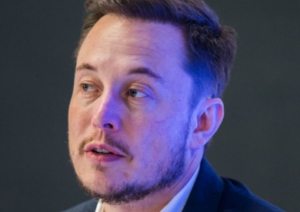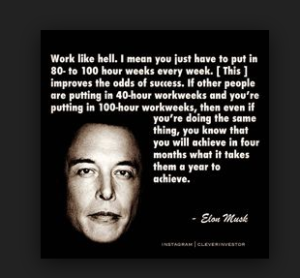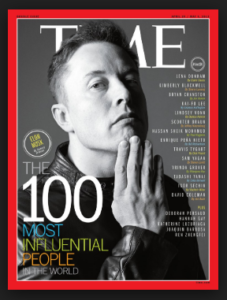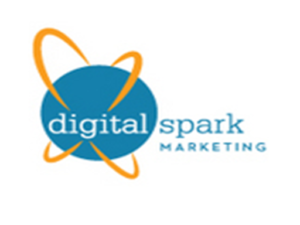Much has been written about Elon Musk in the last year, and a lot of it makes us rethink the man. Makes us rethink what we knew or thought we knew. And lots that remind you of Elon Musk.

Elon Musk has always been a thinker, a creator, and an eccentric. As a child, he daydreamed in an almost trance-like manner and coded his video games.
He always found resourceful ways to make money, and after he graduated from college, he opted for entrepreneurship rather than wait for an internet company to take notice of him.
Still the same old Elon, right? And more eccentric all the time, just like another historical personality.
Numerous passions inspire Musk, and today he manages companies and projects that specialize in electric and self-driving cars, private space exploration and Mars colonization, solar energy and artificial intelligence. More about these momentarily. But first a little background on entrepreneurship.
Entrepreneurship in America recently hit a 40 year low, with far less business creation and new jobs coming from startups than in the past. Productivity numbers show a similar trend, with levels today far below what they were in previous decades. Clearly, these trends are troubling signs that need to be reversed.
To many, this is surprising because we seem to see innovation all around us, from smarter smartphones to speakers that talk to us and respond to our commands. However, the truth is that information and communication technology makes up only 6% of advanced economies. Silicon Valley isn’t going to build the future alone..
On average, it takes about 30 years to go from initial discovery to significant market impact and we are about a decade into the next great transformation. That puts us almost exactly where those Xerox executives were in 1977. They had no idea of what personal computers would unleash and if we’re honest, we need to admit that we are in the same boat.
What we can do is recognize that there is a great transformation underway that will unlock possibilities and opportunities that are impossible to see clearly right now. However, it is more critical to explore than to predict and that’s what we need to do today. We don’t need to understand the future to be open to it.
But there are lots of parallels of an entrepreneur personality that reminds you about Elon Musk. Can you guess who it is?
Who Is Elon Musk?
Elon Reeve Musk (born June 28, 1971) is a South African-born American entrepreneur and businessman who founded X.com in 1999 (which later became PayPal), SpaceX in 2002 and Tesla Motors in 2003.
Musk became a multimillionaire in his late 20s when he sold his start-up company, Zip2, to a division of Compaq Computers. Lots of similarities in personal wealth between the two.
Musk made headlines in May 2012, when SpaceX launched a rocket that would send the first commercial vehicle to the International Space Station.
Education
At age 17, in 1989, Elon Musk moved to Canada to attend Queen’s University and avoid mandatory service in the South African military. He left in 1992 to study business and physics at the University of Pennsylvania. He graduated with an undergraduate degree in economics and stayed for a second bachelor’s degree in physics.
After leaving Penn, Elon Musk headed to Stanford University in California to pursue a Ph.D. in energy physics. However, his move was timed perfectly with the Internet boom, and he dropped out of Stanford after just two days to become a part of it, launching his first company, Zip2 Corporation.
An online city guide, Zip2 was soon providing content for the new websites of both The New York Times and the Chicago Tribune. In 1999, a division of Compaq Computer Corporation bought Zip2 for $307 million in cash and $34 million in stock options.

Lots of irons in the fire, so to speak. Lots of similarities also.
Here are some of his well-known businesses:
Zip2
In 1995, Musk and his brother, Kimbal, started Zip2, a web software company, with money raised from a small group of angel investors. The company developed and marketed an Internet “city guide” for the newspaper publishing industry.
While at Zip2, Musk wanted to become CEO; however, none of the board members would allow it. Compaq acquired Zip2 for US$307 million in cash and US$34 million in stock options in February 1999. Musk received US$22 million for his 7 percent share from the sale.
Not too similar here between the two.
X.com and PayPal
In March 1999, Musk co-founded X.com, online financial services, and e-mail payment company, with US$10 million from the sale of Zip2. One year later, the company merged with Confinity, which had a money transfer service called PayPal. The merged company focused on the PayPal service and was renamed PayPal in 2001.
Musk was ousted in October 2000 from his role as CEO (although he remained on the board) due to disagreements with other company leadership, notably over his desire to move PayPal’s Unix-based infrastructure to Microsoft Windows.
In October 2002, PayPal was acquired by eBay for US$1.5 billion in stock, of which Musk received US$165 million.] Before its sale, Musk, who was the company’s largest shareholder, owned 11.7% of PayPal’s shares.
Both of these business leaders need to be in control.
SpaceX
Musk founded his third company, Space Exploration Technologies Corporation, or SpaceX, in 2002 with the intention of building spacecraft for commercial space travel.
With US$100 million of his early fortune, Musk founded Space Exploration Technologies, or SpaceX, in May 2002. Musk is a chief executive officer (CEO) and chief technology officer (CTO) of the Hawthorne, California-based company.
SpaceX develops and manufactures space launch vehicles with a focus on advancing the state of rocket technology. The company’s first two launch vehicles are the Falcon 1 and Falcon 9 rockets (a nod to Star Wars’ Millennium Falcon), and its first spacecraft is the Dragon (a nod to Puff the Magic Dragon).
In seven years, SpaceX designed the family of Falcon launch vehicles and the Dragon multi-purpose spacecraft. In September 2008, SpaceX’s Falcon 1 rocket became the first privately funded liquid-fueled vehicle to put a satellite into Earth orbit.
On May 25, 2012, the SpaceX Dragon vehicle berthed with the ISS, making history as the first commercial company to launch and berth a vehicle to the International Space Station
In late 2017, SpaceX unveiled the design for its next-generation launch vehicle and spacecraft system—BFR—that would support all SpaceX launch service provider capabilities with a single set of very large vehicles: Earth-orbit, Lunar-orbit, interplanetary missions, and even intercontinental passenger transport on Earth, and totally replace the Falcon 9, Falcon Heavy and Dragon vehicles in the 2020s.
Tremendous similarities between the two technologies of these two businessmen.
Tesla

Elon Musk is the co-founder, CEO and product architect at Tesla Motors, a company dedicated to producing affordable, mass-market electric cars as well as battery products and solar roofs.
Musk oversees all product development, engineering, and design of the company’s products. Just like you-know-who.
Five years after its formation, in 2008, the company unveiled the Roadster, a sports car capable of accelerating from 0 to 60 mph in 3.7 seconds, as well traveling nearly 250 miles between charges of its lithium-ion battery.
With a stake in the company taken by Daimler and a strategic partnership with Toyota, Tesla Motors launched its initial public offering in June 2010, raising $226 million.
Additional successes include the Model S, the company’s first electric sedan. Capable of covering 265 miles between charges, the Model S was honored as the 2013 Car of the Year by Motor Trend magazine.
Can you think of the two transportation industries that represent these two individuals? This could be the give-away clue.
Below are 12 surprising facts about Musk that paints a picture of the eccentric multi-disciplinary engineer.
Reminds you of Elon Musk … a loner early
When Musk was a child, he would often gaze into the distance while his parents were speaking to him, which led them to believe that he might be hard of hearing. Doctors removed his adenoids, but it made no difference.
Both of these individuals were loners.
Often bullied
Growing up in South Africa, Musk’s classmates bullied him and beat him up badly. At age 41, he had surgery to fix a deviated septum.
Early creator
It was called Blaster, and Musk, then 12, received $500 when its source code was published in the South African magazine PC and Office Technology. In 2015, a Google software engineer revised the code to function in HTML5 and made it playable.
The objective of the game is to destroy an alien ship filled with weapons of mass destruction. While it’s a rudimentary game, don’t forget that it was created by a preteen nearly 33 years ago.
“[It was] a trivial game … but better than Flappy Bird,” Musk told WaitButWhy.
Paid for college as an entrepreneur
While studying at the University of Pennsylvania, the natural entrepreneur would throw house parties and charge a cover fee of $5 to help him pay his rent.
He and his roommate were the only residents of a 10-bedroom frat house, and they would cover the windows with black trash bags and the walls with bright paint.
Did not finish
In 1995, Musk enrolled in graduate school at Stanford University to study physics. Within two days he decided that the internet had far greater promise to change society and left to found Zip2, a company that provided maps and directories to online newspapers.
Father of five
Musk has five sons with his ex-wife Justine Wilson. Twins Griffin and Xavier were born in 2004, and triplets Damian, Saxon, and Kai were born in 2006.
The couple also had a son named Nevada, born in 2002 and named after the location of Burning Man, the music and arts festival where he was conceived, though he died of sudden infant death syndrome at ten weeks of age.
Reminds you of Elon Musk … risk taker
Amid the Great Recession and expensive divorce from his first wife, Wilson, who blogged about her demands on LiveJournal, Musk was living off loans from his wealthy friends.
Musk put his last $35 million into Tesla and maintained his stake in the company, despite his lack of cash. Tesla went public, and today it’s valued at more than $33.4 billion, while Musk himself is worth $12.7 billion, according to Forbes.
It reminds you of Elon Musk … both individuals were big risk takers.
Continuous Learner
Musk is knowledgeable about many disciplines, and many people wonder how he can educate himself so effectively. During a Reddit AMA in 2015, a user asked about his process.
Musk replied, “I do kinda feel like my head is full! My context switching penalty is high, and my process isolation is not what it used to be. Frankly, though, I think most people can learn a lot more than they think they can. They sell themselves short without trying.
Lots of ideas
Civilization has developed planes, trains, automobiles, and boats, but Musk envisions his conceptual Hyperloop high-speed transit tube as a fifth mode.
He says it is theoretically the fastest way to travel the California coast. It would never crash, it would be immune to weather, and it would get passengers from Los Angeles to San Francisco in under 30 minutes.
Owns many Bel Air mansions
One Bel Air mansion wasn’t enough for the Tesla co-founder. Musk now owns five mansions in the lavish southern-California neighborhood, worth a total of more than $70 million.
Of course, they are eco-friendly — an aerial image of Musk’s main home shows massive solar panels on one side of the property.
AI is the biggest existential threat
Musk is incredibly leery of AI. He fears that AI could become more powerful than people and perhaps cause human extinction if it grows too smart.
In an interview with Vanity Fair, Musk explained that it’s technically not a robot that would become too powerful, but a computer algorithm.
“The important thing is that if we do get some runaway algorithm, then the human AI collective can stop the runaway algorithm. But if there’s large, centralized AI that decides, then there’s no stopping it.”
Musk isn’t the only one to fear the power of AI. Other tech leaders and scientists are on the same page as the SpaceX founder, including Stephen Hawking and Bill Gates.
Addicted to caffeine
For a period in his life, Musk reportedly drank eight cans of Diet Coke in addition to several cups of coffee each day.
It was his means of staying awake and focused during 100-hour work weeks during the process of building and launching his companies; he told Inc. in 2007.
The bottom line
The answer, of course, is Howard Hughes. He was a technologist in aviation with many inventions. He was a successful businessman in the airline business. And he was more or less self-made.
Is Elon Musk headed down the same slippery path as Howard Hughes?
What do you think?
